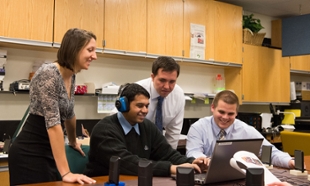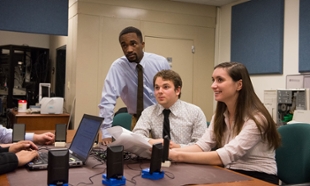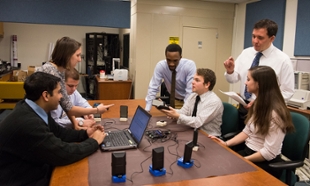Student-designed testing system to aid hearing research
NewsHow would your life be different if you could hear out of just one ear?
How would your life change if surgery suddenly allowed you to hear out of both ears after having spent a significant part of your life only able to hear out of one?
JMU researcher Dr. Lincoln Gray has spent a good bit of his career investigating the answers to those two questions, and now his research could be on the verge of a breakthrough with help from a device being designed and built by a group of JMU students.

The student group includes four senior engineering majors and two junior engineering majors advised by Dr. Robert Nagel, an assistant professor of engineering. Also part of the team is a senior communication sciences and disorders major being advised by Gray. The team will give a presentation on the device, a distributable hearing test, during the 2013 Engineering Poster Fair from 2-5 p.m. April 19 in the Rose Library flex space.
The system is being designed to evaluate and collect data from patients who have had surgery to correct congenital aural atresia, a condition caused by a deformed external auditory canal. "The auditory receptor, the part that does the work of sending those sound messages to the brain is intact and ready to go, it just doesn't get any sound in," said Gray, a professor of communication sciences and disorders.
Surgery can correct the problem and no one does more surgery on aural atresia patients than Gray's colleague at the University of Virginia Medical Center, Dr. Bradley Kesser. Gray and Kesser know the surgery has some short-term benefits, but they lack data on most patients after their first follow-up visit. "I've never been able to follow them up basically more than a month because the insurance companies will only pay for them to come back to U.Va. for the one-month post-op visit, and that's when Dr. Kesser pulls the packing out of their ear and basically they hear for the first time," Gray said.
Because many of Kesser's patients come from across the country as well as from other countries, getting them to come back for further testing and study is cost-prohibitive in most cases. The hearing test system is being designed so it can be shipped to patients, who will be able to do the tests themselves and then return the device and the data. The system consists of a laptop computer; eight speakers; a mat on which the system is set up; custom software; instructions for setting up and using the system; and the packaging.
"I don't think there's a machine like this out there yet that specifically localizes sound and that you can do yourself," said Sofie Ganev, the communication sciences and disorders major. Ganev is using test results from the system for her honors thesis.

Brandon Lancaster, one of the four senior engineering majors and the team leader, said, "I think everyone's had the experience of going to the doctor and putting on the headphones with the pure-tones and then you raise your hand if you hear the tone. So that's an example of an audio test that determines your pure-tone threshold, but our tests are designed to measure hearing abilities that are enhanced by the listener having two ears."
Added senior engineering major Michael Kessler, "Sound-localization is directly related to the users ability to hear from both ears. A sound originating at the right ear will arrive at the right ear some amount of time before arriving at the left ear. The difference in time of arrival is known as interaural time delay. Designing a free-field sound-localization test based on the principles of ITD and head shadow provides a way to quantify the difference in hearing between a monaural and a binaural listener."
One of the tests requires patients to identify which of eight speakers a sound is coming from. The sound is controlled by the software, which randomly selects a speaker to play the sound. Another test requires patients to figure out what a voice is saying while noise is coming from a different speaker.
A tricky part of designing the system is calibrating it so people with unilateral hearing loss fail most of the time and people with two good ears succeed most of the time. That's where Ganev, who is deaf in her right ear, has focused. But finding people to test has been difficult and some tests have been run placing an earplug in an ear of people with normal hearing.
"It was interesting that we (people with normal hearing but with an earplug ) were worse than people who have lived their whole life hearing out of only one ear," Gray said. "So Sofie has an interesting hypothesis about how we might learn to do that."

There have been hurdles to overcome in designing the system too. "What Jonathan (Smith) and I have been working on this semester and part of last semester is the user aspect, making sure the user knows where to connect certain pieces, working on the instructions, making it so you don't have to have a high level of familiarity with the technology to set it up," said Brian Allen. "In our original design, they had 30 things to connect and now we're down to 10 or 11."
Allen also has been busy creating parts for the system and its packaging with a 3-D design program and a 3-D printer. Lancaster said the design may be further refined based on testing that will be videotaped. The junior engineering students, Brittany Harwell and Tony Battu, will continue to work with Nagel and Gray to refine the design as well as scale up testing with post surgery patients during the next academic year.
In addition to the symposium at JMU, the team will be presenting the project April 26 at the 2013 IEEE Systems and Information Engineering Design Symposium at the University of Virginia. The event will provide an opportunity for the group to present their work to other engineers and will result in the publication of a paper.
Gray said he is considering collaborating with the University of North Carolina, where the hearing test could be useful for testing aural atresia patients who are receiving an implantable device, which was designed by JMU Professor Jonathan Spindel, rather than surgery. The test could help determine if one remedy is better than the other, he said.

